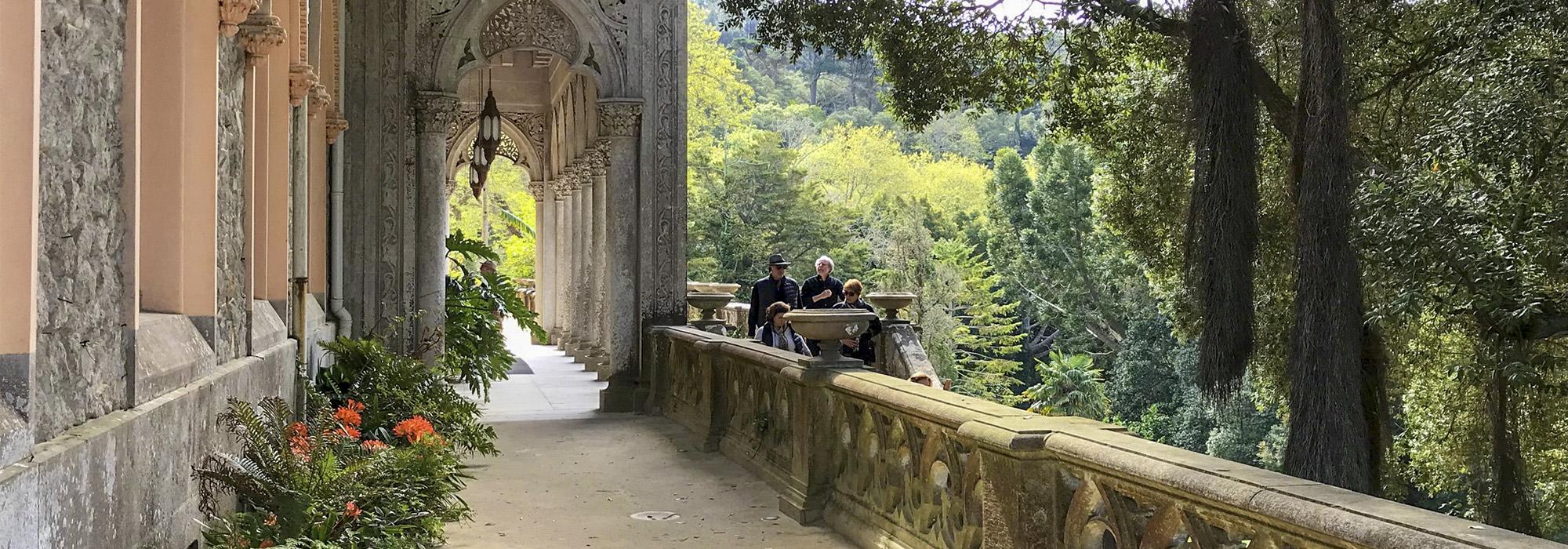The Hidden Treasures of Portugal
Several great private estates and national cultural treasures in Portugal were among the many highlights of TCLF’s third international excursion. Attendees were treated to more than a week of sunny skies, temperatures in the 60s, and an abundance of fragrant wisteria and jasmine in bloom – and we discovered our new favorite drink, Port Tonic (recipe below).
On the heels of last year’s wildly successful trip to Madrid, there was great interest in another Iberian excursion. The tour was organized by Susan Gullia’s New York-based Protravel and led by Sophia Barroso, president of Around Art (who led last year’s Madrid tour); TCLF Stewardship Council Member Susana Canogar, a landscape architect based in Madrid, joined the group for the Lisbon portion of the tour.
The adventure began in the northern hill city of Porto at the Pestana Palacio do Freixo, a former Baroque Palace and mill that has been converted to a luxury hotel overlooking the Douro River. An afternoon tour included stops at the Cordoaria Garden and beloved sculptures of laughing figures by the Spanish artist Juan Muñoz, and a sunset visit to the seaside Leça Swimming Pools designed by Pritzker Prize-winning Portuguese architect Alvaro Siza, followed by dinner at the new home of Siza’s son Alvarhino.
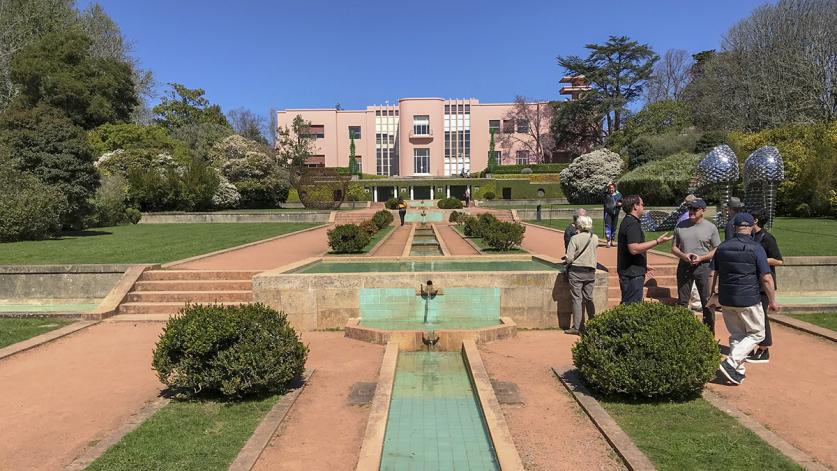
As with TCLF’s previous tours in Japan (2017) and Madrid (2018), participants in Portugal were provided with a carefully curated look at the country’s cultural highlights, which included an exclusive tour of Porto’s Casa da Música, a concert hall designed by the Dutch architect Rem Koolhaas. The asymmetrically shaped complex opened in 2005, and our group found its mix of contemporary minimalism and traditional design elements – including a baroque pipe organ and creative use of blue and white tiles – absolutely captivating. The next stop was the Serralves Foundation, which features an Art Deco mansion with an elegant, tiered landscape and water garden by the great French practitioner Jacques Gréber. The site also includes a museum designed by Alvaro Siza that was hosting an exhibition of amusing, contemporary baroque sculpture by Joana Vasconcelos.
The next day included a drive to Santo Tirso where we visited Caso do Casal, an extensive camellia farm and garden owned by the Gil Family. Manuel and Clara Gil provided a warm welcome in the entry courtyard, which includes a majestic fountain in the center surrounded by various tree-sized camellias in bloom. The property ambled over several acres of groves and wooded areas and includes hideaways with pools, picturesque assemblages of architectural elements, shrines, and other delightful surprises.
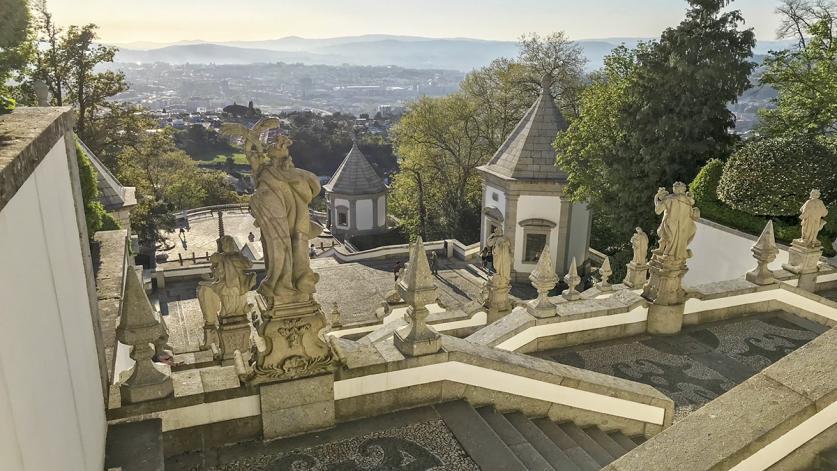
We continued on to Braga and the nineteenth-century home of Mario and Paola Sequeria, which is adjacent to their gallery of contemporary art and a sculpture garden. The Galeria Duarte Sequeira is housed in an all white contemporary structure designed by Carvalho Araújo and nestled within a broad, sloping, grass plane. Following a tour of the gallery and grounds, the Sequerias provided a sumptuous lunch and concluded with a short, impromptu piano recital by Mario (and everyone signing "Happy Birthday" to tour attendee Doug Reed, FASLA). The group then continued on to the hilltop Baroque garden and shrine of Bom Jesus do Monte, one of the most famous and popular pilgrimage sites in Portugal. The main basilica is accessed by zigzagging stairways that scale the hillside nearly 400 feet; along the way are shrines with terra cotta figures representing the Passion of Christ, and fountains dedicated to the five senses. At the nearby Pousada de Santa Maria, a former convent, we caught our breath and sipped tea in the tile-adorned cloister garden.
On Thursday we departed for the long drive south to Lisbon, with stops at two exceptional sites.The first was the Palácio de Mateus (in the historic town of the same name), which is hidden from the street and accessed by a winding driveway that leads to a vast square-shaped pool (referred to as “the Lake,” this addition, which reflects the main façade, was added in the 1950s) and the stunning eighteenth-century palace. As with many buildings in northern Portugal, the palace is constructed with granite, which is abundant in the region. Windowsills, dormers, and other architectural elements are hewn from slabs of unadorned, grey granite that contrasts with the palace’s whitewashed walls.The complex includes a series of parterre gardens with meticulously clipped hedges in arabesques and other patterns. Two of the ornate gardens are separated by a vast series of cedars that have been carefully pruned to create a tall tunnel that leads to the property’s vineyards.
From there, it was a ride to the small town of Santar (pop. 1,000), where we had lunch and met with Jos Luis de Vasconcelos, the Count of Santar, who has been systematically and lovingly working to rehabilitate the town. The count highlighted the new community garden, which had been created from a series of plots once divided by walls and traversed with overhead wires and poles (now gone). He also led us though the vineyard designed by Spanish landscape architect Fernando Caruncho. The group marveled at the sensitivity and aptness of the new work, which was sympathetically integrated into Santar’s historic, vernacular landscape.
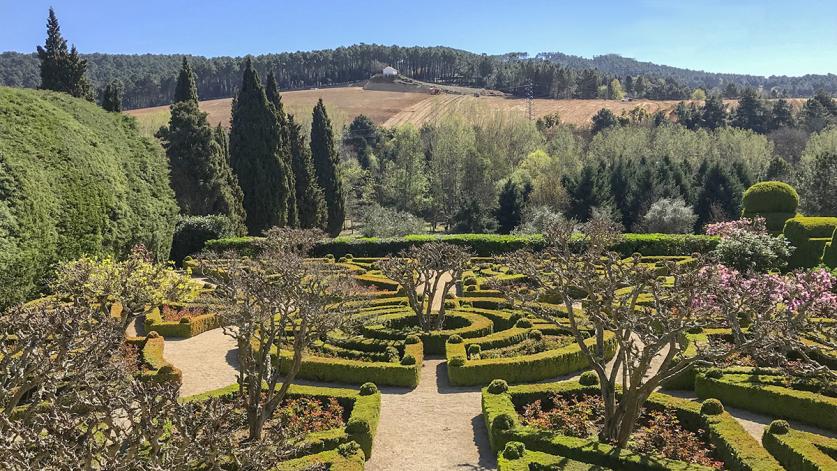
The Lisbon leg of the journey began in the nearby town of Setubal at the Quinta da Bacalhôa, a royal property whose origins date to the early fifteenth century. The remarkably ornate garden is arranged around a central fountain. Each parterre displays a different boxwood pattern, and each has a distinct meaning: an "R" at the center of one symbolizes rei, which refers to the king of Portugal. Topiaries in the form of slender obelisks punctuate the courtyard garden and add height and interest when viewed at eye-level.
That evening featured dinner at the palace and gardens of the Marquis of Fronteira, built in the seventeenth century and still owned by the Mascarenha family. We began with a twilight walk through the gardens, led by landscape historian and author Cristina Castel-Branco. The palace garden is richly encrusted with Portuguese tiles with deftly painted images that represent the different arts, as well as mythological figures. There is also a stone staircase that leads up to a wall lined with busts of the Kings of Portugal. The Hall of Battles has been called the Sistine Chapel of tile work.

This second Iberian excursion would not be complete without a trip to Sintra, a UNESCO World Heritage Site. Highlights included the palace and gardens of Monserrate, which was started by Englishman William Beckford in the eighteenth century and then expanded into an eclectic Moorish palace in the mid-1850s by English textile millionaire Sir Francis Cook, who used the property as a family summer residence. The estate sprawls over a hilly 80+ acres and features thematic sections, including a Mexican Garden, Japanese Garden, Rose Garden, Pohutukawa (with plants native to New Zealand), and others, along with architectural follies and what is purportedly the first lawn planted in Portugal. This was followed by lunch at the Quinta de São Sabastião, the private country home of the Countess of Asseca. The day continued with a visit to Quinta da Alegria, the private home of Sissi von Schmider, who has spent the past decade rehabilitating the home and its collection of gardens on one of Sintra’s hillsides. Von Schmider, who is from Switzerland, and her head gardener, landscape architect Markus Treppo, who hails from Austria, were as charming and generous as the gardens were breathtaking and revelatory. The visit concluded with tea and refreshments, and each guest received a small glass container of orange preserves made onsite.
The final day began at the Gulbenkian Foundation Museum and Gardens, created by the Armenian oil tycoon Calouste Gulbenkian. The world-renowned collection of art and artifacts covers millennia and includes Egyptian, Greco-Roman, Islamic and Oriental art, Netherlandish, and Italian Renaissance paintings, works by French Impressionists, and a wing dedicated to sculpture and paintings by artists from Portugal and Spain. The modernist garden’s planes and geometries recalls Lawrence Halprin’s work in the Pacific Northwest. The day concluded with a visit to MAAT, Lisbon’s new Museum of Art, Architecture and Technology, which is adjacent to the Tajo Power Station, the electrical station that once powered portions of the city and has now been turned into an impressive museum. The MAAT building was designed by Amanda Levete and features a sloped green roof that provides extraordinary views of the Tagus River. The main, oval-shaped exhibition space housed an installation by Tadashi Kawamata that featured plastic refuse from the sea that was suspended in a giant filament mesh. Viewers could peer down onto the installation and then follow a ramp down to see the work from below. This collection of garbage was transformed into an eerily beautiful paean to the pollution that threatens our seas and oceans.
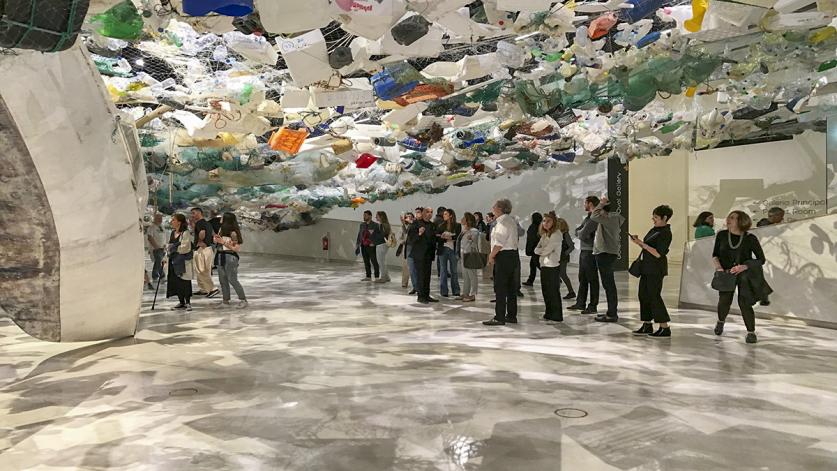
Like TCLF’s earlier tours of Japan and Madrid, the excursion to Portugal provided a “taste,” as our guide Sophia put it, of the country’s rich cultural and historic legacy. The trip succeeded in leaving everyone intellectually sated and still wanting more, and offered a selection of meals at private estates and superb restaurants that provided insights into Portugal’s unique culinary heritage.
Oh, and one last thing: Our new favorite drink (which we'll be having all summer), Port Tonic. One part White Port, two parts tonic, fresh mint and lemon peel over ice. It’s light and refreshing, and it even appealed to the most tonic-averse in our group.



